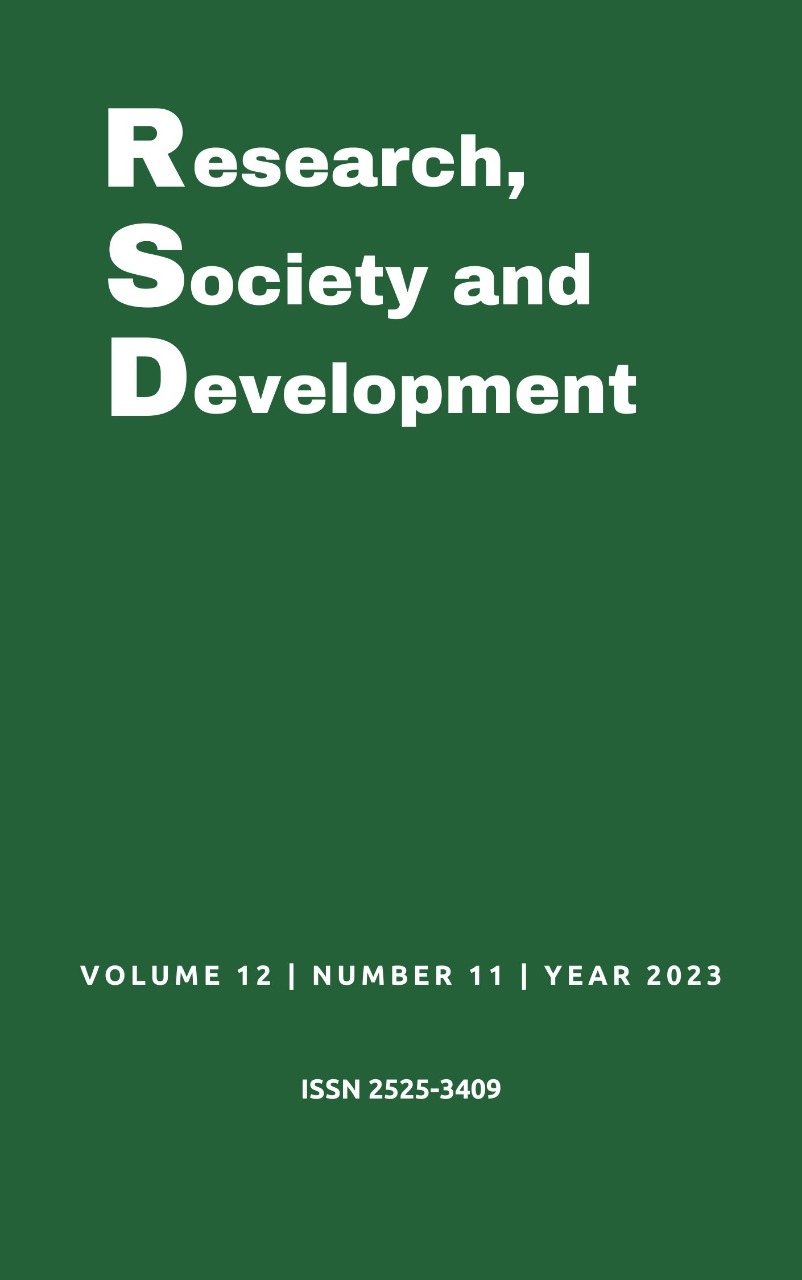Estimulação cerebral profunda como tratamento para a doença de Parkinson
DOI:
https://doi.org/10.33448/rsd-v12i11.43792Palavras-chave:
Neurocirurgia, Estimulação cerebral profunda, Doença de Parkinson.Resumo
Introdução: A doença de Parkinson (DP) é a segunda doença neurodegenerativa mais comum e tem vindo a aumentar em prevalência nas últimas décadas. A estimulação cerebral profunda (DBS) é um tratamento estabelecido para a doença de Parkinson (DP) grave, distonia e tremor, e tem um papel emergente em uma série de outras condições neurológicas e neuropsiquiátricas. No entanto, a sua adoção generalizada é atualmente limitada pelo custo, efeitos colaterais e eficácia parcial. Objetivo: explicar e descrever o método de Estimulação Cerebral Profunda para controle e tratamento da Doença de Parkinson. Metodologia de busca: trata-se de uma investigação descritiva do tipo revisão integrativa de literatura, por meio de acesso on-line às bases de dados PubMed, Scielo, CDSR, Google Acadêmico, BVS e EBSCO, em setembro de 2021. Resultados e discussão: DBS pode interagir com redes neurais patológicas em uma forma que às vezes estimula e às vezes inibe certas vias para eliminar ou subjugar o circuito indesejado nas alças dos gânglios da base, esse mecanismo ficou conhecido como “bloqueio” da rede doente. A estimulação controlada reduz essa hiperatividade e consequentemente remove ruídos, restabelecendo a transmissão das informações neurais e, consequentemente, devolvendo o controle do movimento. Considerações finais: o tratamento consiste na estimulação elétrica em diferentes regiões do cérebro, durante anos sem interrupção. A corrente elétrica utilizada é muito pequena, feita em pontos estratégicos do cérebro através da implantação de eletrodos, que são, em sua maioria, profundos.
Referências
Abboud, R. H., et al. (2014). Rastreamento de Estimulação Cerebral Profunda Abrangente e Multidisciplinar para Pacientes de Parkinson: Não há espaço para “atalhos”. Prática Clínica de Distúrbios do Movimento, 11 (4), 336-341.
Asahi, N. T., et al. (2014). Impacto da estimulação subtalâmica bilateral nas funções motoras/cognitivas na doença de Parkinson. Neurologia Medico-Chirurgica, 54 (7), 529-536.
Aum, D. J., et al. (2021). Estimulação cerebral profunda: fundamentos e tendências futuras. Tese de Doutorado em Medicina – Faculdade de Medicina da Universidade de São Paulo, 1-176.
Castner, J. E., et al. (2018). Efeitos da estimulação cerebral profunda subtalâmica na geração de substantivos/verbos e seleção de alternativas concorrentes na doença de Parkinson. Journal of Neurology, Neurosurgery & Psychiatry, 79 (6), 700-705.
Habets, J. G. V., et al. (2018). An update on adaptive deep brain stimulation in Parkinson’s disease. Movement Disorders, 33 (12), 1834–1843.
Houeto, V. J. L., et al. (2012). Distúrbios comportamentais, doença de Parkinson e estimulação subtalâmica. Journal of Neurology, Neurosurgery & Psychiatry, 72 (6), 701-707.
İbrahimoğlu, O., et al. (2020). The Experiences of Patients with Deep Brain Stimulation in Parkinson’s Disease: Challenges, Expectations, and Accomplishments. Acta Medica Academica, 49 (11), 36–43.
Kogan, M., et al. (2019). Deep Brain Stimulation for Parkinson Disease. Neurosurgery Clinics of North America, 30 (2), 137–146.
Krack, A. P., et al. (2013). Seguimento de cinco anos de estimulação bilateral do núcleo subtalâmico na doença de Parkinson avançada, The New England Journal of Medicine, 349 (20), 1925-1934.
Liu, Z., et al. (2020). General anesthesia versus local anesthesia for deep brain stimulation in Parkinson’s disease: A meta-analysis. Stereotactic and Functional Neurosurgery, 97 (6), 381–390.
Malek, N. (2019). Deep Brain Stimulation in Parkinson's Disease. Neurology India, 67 (6), 968 – 978.
Mehanna, R., et al. (2013). Estimulação cerebral profunda na doença de Parkinson. Neurodegeneração translacional, 2 (22), 1-9.
Odekerken, T. V. J., et al. (2013). Núcleo subtalâmico versus estimulação cerebral profunda bilateral do globo pálido para a doença de Parkinson avançada (estudo NSTAPS): um estudo controlado randomizado. Lancet Neurol., 12 (1), 37–44.
Okun, M. S., et al. (2012). Doença de Parkinson DBS: O que, quando, quem e por quê? Chegou a hora de adaptar os alvos de DBS. Expert Review of Neurotherapeutics, 10 (12), 1847-1857.
Pedrosa, D. J., et al. (2013). Revisão: gestão da doença de Parkinson. Doença e Tratamento Neuropsiquiátrico, 9 (7), 321-340.
Ramirez-Zamora, A., et al. (2018). Globus pallidus interna or subthalamic nucleus deep brain stimulation for Parkinson disease a review. JAMA Neurology, 75 (3), 367–372.
Rammo, R., et al. (2021). The Need for Digital Health Solutions in Deep Brain Stimulation for Parkinson’s Disease in the Time of COVID-19 and Beyond. Neuromodulation, 24 (2), 331–336.
Schüpbach, N. V. M., et al. (2015). Estimulação do núcleo subtalâmico na doença de Parkinson: um acompanhamento de 5 anos, Journal of Neurology, Neurosurgery & Psychiatry, 76 (12), 1640-1644.
Silveri, N. M. C., et al. (2012). Efeitos da estimulação do núcleo subtalâmico na nomeação e leitura de substantivos e verbos na doença de Parkinson. Neuropsicologia, 50 (8), 1980–1989.
Wang, J., et al. (2020). Comparison of Awake and Asleep Deep Brain Stimulation for Parkinson’s Disease: A Detailed Analysis Through Literature Review. Neuromodulation, 23 (4), 444–450.
Downloads
Publicado
Edição
Seção
Licença
Copyright (c) 2023 Antonio Solon Mendes Pereira; Marcus Geovane da Silva Araújo; Roberta Leal Bezerra Nascimento; Camilo Bruno Melo de Souza Garcia; Natasha Batilieri Rodrigues; Jamile Ballut Breval; Miriam Monteiro Pereira; Patrícia dos Santos Monteiro; Aline Neves dos Santos; Hádilla Maria do Desterro Gonçalves Cavalcante

Este trabalho está licenciado sob uma licença Creative Commons Attribution 4.0 International License.
Autores que publicam nesta revista concordam com os seguintes termos:
1) Autores mantém os direitos autorais e concedem à revista o direito de primeira publicação, com o trabalho simultaneamente licenciado sob a Licença Creative Commons Attribution que permite o compartilhamento do trabalho com reconhecimento da autoria e publicação inicial nesta revista.
2) Autores têm autorização para assumir contratos adicionais separadamente, para distribuição não-exclusiva da versão do trabalho publicada nesta revista (ex.: publicar em repositório institucional ou como capítulo de livro), com reconhecimento de autoria e publicação inicial nesta revista.
3) Autores têm permissão e são estimulados a publicar e distribuir seu trabalho online (ex.: em repositórios institucionais ou na sua página pessoal) a qualquer ponto antes ou durante o processo editorial, já que isso pode gerar alterações produtivas, bem como aumentar o impacto e a citação do trabalho publicado.


